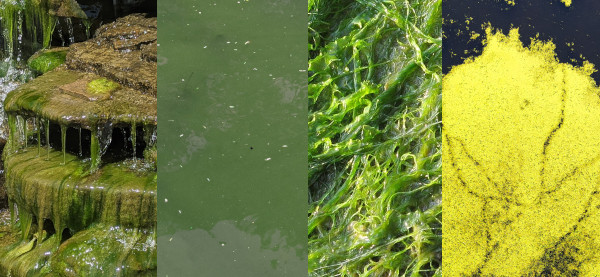What is Algae?
Pond algae is one of the most common problems pond owners face while maintaining a pond, lake, or water feature and it's a completely normal part of a ponds ecosystem. It forms a big and diverse group of eukaryotic organisms that love sunlight, warmth, and high-nutrient bodies of water like your pond. Like plants, this organism uses photosynthesis to convert light into energy. It doesn't have a root system like traditional plants and often grows floating on the waters surface, across submerged surfaces, or in the water column. In abundance, troublesome algae will mat on the surface or spread throughout the water column shading your pond, preventing plant growth & reducing oxygen content. If left unchecked it can deplete your pond of oxygen killing fish and other organisms.

Algae does have benefits and a little in your pond is necessary for a healthy and balanced ecosystem. It contributes as a food source for infusoria, small fish (like baby fry) and insects. Algae also provides places for micro-organisms to live or hide and, while problematic in abundance, it does absorb excess nutrients in the water.
What Causes Algae Blooms?
A bloom is the result of rapid reproduction and an increase in population of algae within the body of water. Blooms are typically caused by an increase of nutrients in the water and/or direct sunlight, allowing the organisms to grow excessively and rapidly. Fertilizer run-off, decaying debris, and over-feeding fish are examples of how excess nutrients enter a pond and contribute to algae growth. Other contributing factors include water temperature and the level of competition for nutrients active in the pond. As an example, suspended algae will often bloom in the early spring while the water temperature remains low enough that fish and other organisms have yet to become active, resulting in green "pea soup" water.
Learn about fixing 'Pea Soup' pond water.
Discover how to treat different types of algae.
Pond solutions for treating green algae.
Pond Algae Solutions
Pond Plants To The Rescue
Pond plants play a critical role in maintaining a sustained pond ecosystem and are primary competitors for nutrients and sunlight. Adding a variety of plants to your water garden increases the amount of competition for nutrients in the pond, can decrease the amount of direct sunlight hitting the pond, and improves the overall water quality and aesthetics of your water garden.
Floating Plants, such as Water Hyacinth and Water Lettuce, grow at the water surface and dangle their roots into the water. Floating pond plants generally don't need to be anchored unless you want them to stay in a specific area. Water Hyacinth is an amazing filter, capable of absorbing suspended particles and inorganic substances like heavy metals. It's been used to mitigate waterway pollution, as a filter in the pre-treatment of drinking water, and to filter sewage and wastewater.
Types of pond plants for algae control.
Hardy marginal pond plants great for filtration.
Tropical marginal plants great for filtering water.
Biological Pond Filtration
Biological filtration occurs when beneficial bacteria within the pond cleans the water at a molecular level. In aquatic ecosystems, bacteria colonize surfaces and naturally break down toxins and excess nutrients as the water moves around. Materials with a high surface area such as lava rock, filter mats, and other super pourous media are used to provide more surface for beneficial bacteria to live on and ultimately filter water. Adding media with high surface area near moving water is very effective. We often think of the water pump and filter combinations common in systems, but adding pourous media near aeration zones (bubblers, fountains, and waterfalls) and heavy water movement areas is also very helpful.
Find out about different types of pond filtration.
Discover Bog Filters and their benefits.
Differences in chemical and natural treatments.
Preventative Treatments & Water Cleaners
Water treatments are a fast quick solution, but also temporary unless used in conjuction with other algae reducing methods such as other additives, water filtration, and pond plants. As a quick solution they help put the problem in check, but they don't typically correct it. Removing excess debris rotting in your pond, removing algae from surfaces (typical with filamentous types), and reducing food during fish feeding should be performed in conjuction with preventative treatments. Algaecides and water treatments should always be used as directed on product labelling.
Learn how to test your pond water.
How to maintain a balanced pond ecosystem.
A guide on different water treatment types.